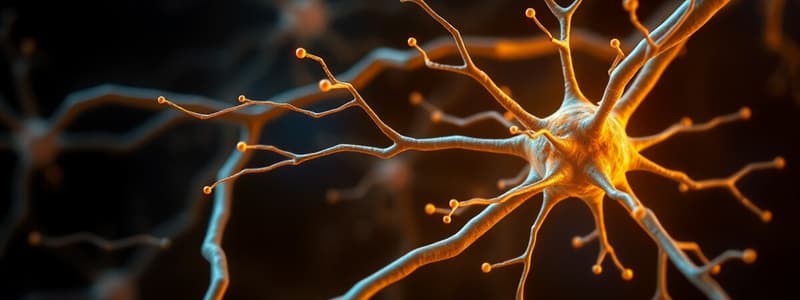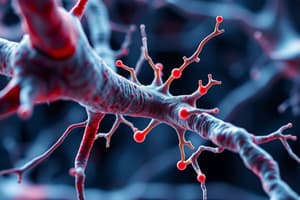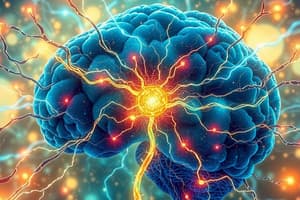Podcast
Questions and Answers
Axo-somatic connectivity refers to the axon connecting to dendrites.
Axo-somatic connectivity refers to the axon connecting to dendrites.
False (B)
The presence of spines on dendrites is essential for the formation of synapses.
The presence of spines on dendrites is essential for the formation of synapses.
True (A)
Axo-axonic connectivity is the most common type of synaptic interaction.
Axo-axonic connectivity is the most common type of synaptic interaction.
False (B)
Neurons integrate synaptic inputs predominantly at the axon hillock.
Neurons integrate synaptic inputs predominantly at the axon hillock.
Dendrites are solely responsible for generating action potentials in neurons.
Dendrites are solely responsible for generating action potentials in neurons.
The architecture of synaptic contacts plays a crucial role in processing incoming messages.
The architecture of synaptic contacts plays a crucial role in processing incoming messages.
Multiple synapses from a single axon can lead to increased precision in signal transmission.
Multiple synapses from a single axon can lead to increased precision in signal transmission.
Graded potentials occur exclusively in the axon of a neuron.
Graded potentials occur exclusively in the axon of a neuron.
GAP junctions consist of two separate membranes that fully merge together.
GAP junctions consist of two separate membranes that fully merge together.
The only difference between channels and GAP junctions is that GAP junctions are paired channels.
The only difference between channels and GAP junctions is that GAP junctions are paired channels.
In the snail aplysia, stimulating the tail leads to the release of ink as part of a defensive mechanism.
In the snail aplysia, stimulating the tail leads to the release of ink as part of a defensive mechanism.
The synaptic delay in the transmission of impulses is approximately 1 second.
The synaptic delay in the transmission of impulses is approximately 1 second.
Ions flow through GAP junctions only through active transport mechanisms.
Ions flow through GAP junctions only through active transport mechanisms.
The release of neurotransmitters occurs after the opening of calcium voltage gated channels.
The release of neurotransmitters occurs after the opening of calcium voltage gated channels.
The amount of neurotransmitter released by one action potential is highly variable and not well-defined.
The amount of neurotransmitter released by one action potential is highly variable and not well-defined.
Calcium concentration is significantly higher inside the cytoplasm than outside under resting conditions.
Calcium concentration is significantly higher inside the cytoplasm than outside under resting conditions.
Micro-domains of calcium increase are crucial for the release of vesicles during synaptic transmission.
Micro-domains of calcium increase are crucial for the release of vesicles during synaptic transmission.
The overall concentration of calcium ions in the synapse determines vesicle release.
The overall concentration of calcium ions in the synapse determines vesicle release.
The active zone of the presynaptic membrane has no geometrical precision in vesicle release.
The active zone of the presynaptic membrane has no geometrical precision in vesicle release.
The amplitude of the graded potential is affected by the amount of neurotransmitter released.
The amplitude of the graded potential is affected by the amount of neurotransmitter released.
Calcium channels ensure that there is an equal distribution of calcium ions inside and outside the cell.
Calcium channels ensure that there is an equal distribution of calcium ions inside and outside the cell.
Pumps are responsible for increasing the intracellular concentration of calcium ions.
Pumps are responsible for increasing the intracellular concentration of calcium ions.
Calcium ions play a minor role in synaptic transmission due to their brief activation time.
Calcium ions play a minor role in synaptic transmission due to their brief activation time.
Calcium ($Ca^{2+}$) acts as a chemical mediator during neurotransmitter release.
Calcium ($Ca^{2+}$) acts as a chemical mediator during neurotransmitter release.
The equilibrium potential of calcium is approximately +130mV.
The equilibrium potential of calcium is approximately +130mV.
The postsynaptic potential can only be excitatory.
The postsynaptic potential can only be excitatory.
The neurotransmitter (NT) is released via a process called endocytosis.
The neurotransmitter (NT) is released via a process called endocytosis.
Calcium enters the presynaptic cell through voltage-gated channels during depolarization.
Calcium enters the presynaptic cell through voltage-gated channels during depolarization.
The binding of neurotransmitters to receptors on the postsynaptic membrane does not influence ion channel activity.
The binding of neurotransmitters to receptors on the postsynaptic membrane does not influence ion channel activity.
Calcium binds to cytoskeletal proteins, aiding in the movement of vesicles.
Calcium binds to cytoskeletal proteins, aiding in the movement of vesicles.
Receptors on the postsynaptic membrane are uniformly distributed across the entire membrane.
Receptors on the postsynaptic membrane are uniformly distributed across the entire membrane.
The postsynaptic current alters the excitability of the presynaptic cell.
The postsynaptic current alters the excitability of the presynaptic cell.
The neurotransmitter's effect can vary based on the type of receptor it binds to.
The neurotransmitter's effect can vary based on the type of receptor it binds to.
Gap junctions enable simultaneous activation of a large number of cells due to their ability to transmit signals rapidly.
Gap junctions enable simultaneous activation of a large number of cells due to their ability to transmit signals rapidly.
In the heart, myocardiocytes are connected only through chemical synapses.
In the heart, myocardiocytes are connected only through chemical synapses.
Electrical synapses can only transmit ions and not metabolic peptides.
Electrical synapses can only transmit ions and not metabolic peptides.
The directionality of an electrical synapse is determined solely by the presynaptic cell.
The directionality of an electrical synapse is determined solely by the presynaptic cell.
Chemical synapses lack a synaptic cleft between the pre and post synaptic membranes.
Chemical synapses lack a synaptic cleft between the pre and post synaptic membranes.
The release of neurotransmitters at chemical synapses occurs via exocytosis.
The release of neurotransmitters at chemical synapses occurs via exocytosis.
Calcium ions play a vital role in the action potential at the presynaptic terminal by opening voltage-gated channels.
Calcium ions play a vital role in the action potential at the presynaptic terminal by opening voltage-gated channels.
Chemical synapses require a direct physical connection between neurons to transmit signals.
Chemical synapses require a direct physical connection between neurons to transmit signals.
The presence of synaptic vesicles in the presynaptic membrane is essential for storing neurotransmitters.
The presence of synaptic vesicles in the presynaptic membrane is essential for storing neurotransmitters.
Synchronous discharges can occur in electrical synapses due to the interconnectedness of neurons through gap junctions.
Synchronous discharges can occur in electrical synapses due to the interconnectedness of neurons through gap junctions.
Flashcards
Axo-dendritic connectivity
Axo-dendritic connectivity
The connection between an axon and a dendrite, where communication occurs via neurotransmitters.
Spines
Spines
Small, specialized structures on dendrites that receive signals from axons, often forming synapses.
Synapse
Synapse
A specialized contact point where an axon releases neurotransmitters, and a dendrite receives them, triggering a signal.
Axo-somatic connectivity
Axo-somatic connectivity
Signup and view all the flashcards
Axo-axonic connectivity
Axo-axonic connectivity
Signup and view all the flashcards
Integration of incoming messages
Integration of incoming messages
Signup and view all the flashcards
Axon hillock
Axon hillock
Signup and view all the flashcards
Synaptic integration
Synaptic integration
Signup and view all the flashcards
Active Zone
Active Zone
Signup and view all the flashcards
Quantal Release
Quantal Release
Signup and view all the flashcards
Postsynaptic Potential
Postsynaptic Potential
Signup and view all the flashcards
Neurotransmitter Release
Neurotransmitter Release
Signup and view all the flashcards
Calcium Microdomain
Calcium Microdomain
Signup and view all the flashcards
Calcium Pumps
Calcium Pumps
Signup and view all the flashcards
Electrochemical Gradient
Electrochemical Gradient
Signup and view all the flashcards
Synaptic Transmission
Synaptic Transmission
Signup and view all the flashcards
SNARE Proteins
SNARE Proteins
Signup and view all the flashcards
Resting Membrane Potential
Resting Membrane Potential
Signup and view all the flashcards
Gap Junction
Gap Junction
Signup and view all the flashcards
Synaptic Delay
Synaptic Delay
Signup and view all the flashcards
Aplysia Model
Aplysia Model
Signup and view all the flashcards
What is the function of electrical synapses?
What is the function of electrical synapses?
Signup and view all the flashcards
What are gap junctions?
What are gap junctions?
Signup and view all the flashcards
Why is the heart considered an electrical syncytium?
Why is the heart considered an electrical syncytium?
Signup and view all the flashcards
What is the directionality of electrical synapses?
What is the directionality of electrical synapses?
Signup and view all the flashcards
What distinguishes a chemical synapse from an electrical synapse?
What distinguishes a chemical synapse from an electrical synapse?
Signup and view all the flashcards
What are neurotransmitters?
What are neurotransmitters?
Signup and view all the flashcards
What are synaptic vesicles?
What are synaptic vesicles?
Signup and view all the flashcards
What are receptors in a chemical synapse?
What are receptors in a chemical synapse?
Signup and view all the flashcards
Explain the process of neurotransmitter release.
Explain the process of neurotransmitter release.
Signup and view all the flashcards
What is exocytosis?
What is exocytosis?
Signup and view all the flashcards
Calcium Influx at Synapse
Calcium Influx at Synapse
Signup and view all the flashcards
Vesicle Fusion
Vesicle Fusion
Signup and view all the flashcards
Neurotransmitter Binding
Neurotransmitter Binding
Signup and view all the flashcards
Postsynaptic Channel Opening/Closing
Postsynaptic Channel Opening/Closing
Signup and view all the flashcards
Postsynaptic Potentials (EPSPs & IPSPs)
Postsynaptic Potentials (EPSPs & IPSPs)
Signup and view all the flashcards
Neurotransmitter Removal
Neurotransmitter Removal
Signup and view all the flashcards
Vesicle Recycling
Vesicle Recycling
Signup and view all the flashcards
Synaptic Precision
Synaptic Precision
Signup and view all the flashcards
Receptor Specificity
Receptor Specificity
Signup and view all the flashcards
Study Notes
Membrane Excitability: Synapses
- Axon potential can be established at the axon hillock or terminal when a minimum intensity (rheobase) is reached.
- Absolute refractoriness is a fixed time period that cannot be shortened.
- Neurons have varying discharge frequencies; different brain regions have distinct neuronal properties.
Signals to Communicate
- Action potentials originate at the axon hillock or axon endings.
- Neurons communicate using action potentials as signals.
- Graded potentials, if strong enough, trigger action potential at the axon hillock.
- Sensory neurons transmit information to the spinal cord or brainstem, then communicate to the brain.
Modalities of Cellular Signaling
- There are different types of cellular signaling, including:
- Nonspecialized synapses:
- Humoral: Hormones released travel and bind their target.
- Paracrine: Local chemical messengers released affect neighboring cells.
- Autocrine: Cells releases molecules that affect themselves.
- Nonspecialized synapses:
- Chemical synapse involves chemical release into the synaptic cleft between neurons, and the receptor cells respond to this chemical signal.
- Electrical synapses involve a direct physical connection (gap junctions) between neurons, allowing ions to flow directly.
Electric Synapses
- Electric synapses use gap junctions to create direct channels for ion flow between membranes.
- There is no pre- or post-synaptic delay in an electric synapse.
- Communication can be bidirectional.
Chemical Synapses
- Chemical synapses use neurotransmitters to transmit signals across the synaptic cleft.
- The pre- and post-synaptic membranes are separated by a space called the synaptic cleft.
- Neurotransmitters are stored in synaptic vesicles.
- An action potential will cause the release of neurotransmitters into the synaptic cleft.
- Neurotransmitters bind to receptors on the post-synaptic membrane.
Model of Study: Snail Aplysia
- Snail aplysia release ink in response to danger stimulation of their tail.
- The number of neurons stimulated correlates with the volume of ink released.
- Neurons that are interconnected by gap junctions cause rapid, simultaneous activation of cells.
Electric Synapses in the Heart
- The heart is an electrical syncytium due to electrical coupling through gap junctions.
- Gap junctions are bidirectional, meaning there's no single direction to signal flow.
Chemical Synapses: Synaptic Cleft
- Contain neurotransmitters that will be released when stimulated by an electric nerve impulse.
- Neurotransmitter release is triggered in the presynaptic membrane by calcium influx.
Synaptic Potentials
- Excitatory postsynaptic potentials (EPSPs): depolarize the membrane toward threshold, potentially triggering action potentials.
- Inhibitory postsynaptic potentials (IPSPs): hyperpolarize the membrane, making it harder to generate action potentials.
Synaptic Integration
- Graded potentials from multiple synapses either summate or cancel, and are integrated in the post-synaptic membrane at the trigger zone.
- Spatial summation occurs when multiple presynaptic neurons release neurotransmitters at once.
- Temporal summation occurs when a single neuron fires multiple times rapidly.
Current to Frequency Coding
- Action potentials are triggered when enough EPSPs summate to reach the threshold, and the frequency of these action potentials reflect the strength of the input.
Paired-Pulse Facilitation and Depression
- Paired-pulse facilitation is an effect where subsequent postsynaptic potentials are larger if preceded by a previous AP, indicating a persisting calcium influx, increasing the likelihood of neurotransmitter release.
- Paired-pulse depression occurs when subsequent EPSPs are smaller than previous ones, meaning calcium influx in the presynaptic cell is affected and reduced due to the depletion of the neurotransmitter vesicles.
The Targets of Neuronal Communication
- The CNS regulates many effectors including cardiac and smooth muscles, most exocrine glands, and adipose tissue.
Clinical case: Neurotransmitter Hypothesis of Depression
- Neurotransmitters can modulate the number of receptors on post-synaptic cells, increasing the responsiveness of the target cells to the signal.
Geometrical Connectivity
- Synapses can be located axodendritically, axosomatically and axo-axonically, meaning synapses can occur on different neuronal regions.
- Synaptic location plays an important role in regulating overall neuronal activity.
Receptors
- Receptors are proteins on the postsynaptic membrane that receive neurotransmitters.
- Ionotropic receptors are channels that open directly by neurotransmitter binding to alter the flow of ions across the membrane.
- Metabotropic receptors are coupled to signaling cascades that ultimately alter ion channel activity.
Neurotransmitter Production and Release
- Neurotransmitters are synthesized in the cell body and transported to the synapse.
- The amount of released neurotransmitter/amplitude of postsynaptic potential depends on the rate of action potentials in the presynaptic terminal.
- The release of neurotransmitters depends on the strength of calcium influx into the presynaptic terminal.
Studying That Suits You
Use AI to generate personalized quizzes and flashcards to suit your learning preferences.
Related Documents
Description
This quiz explores key concepts in synaptic connectivity, focusing on axo-somatic and axo-axonic interactions. It discusses the importance of dendritic spines, graded potentials, and the role of synaptic architecture in neuron signaling. Test your understanding of these fundamental neuroscience principles.




